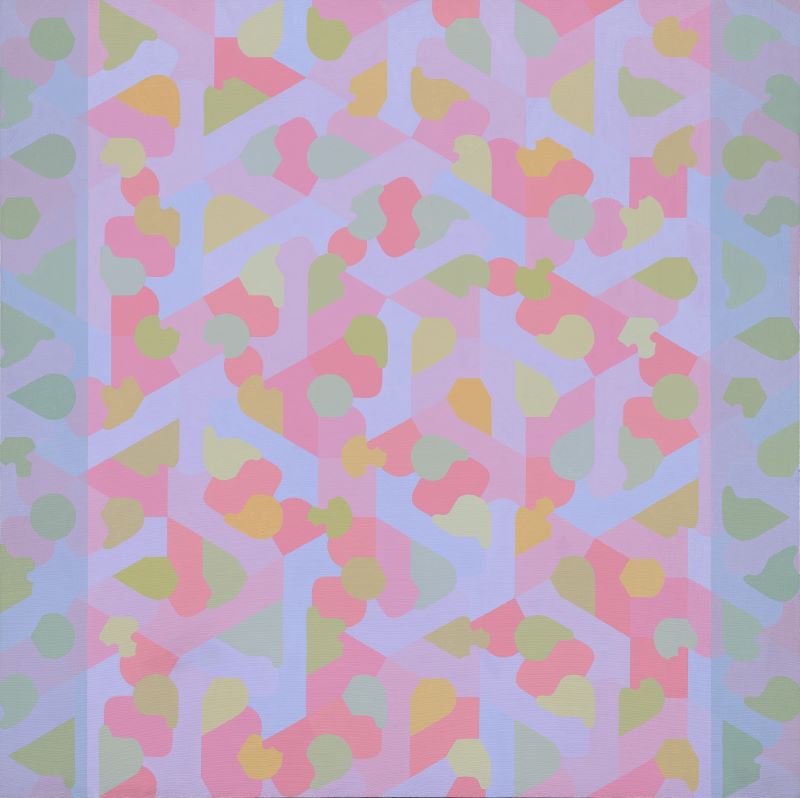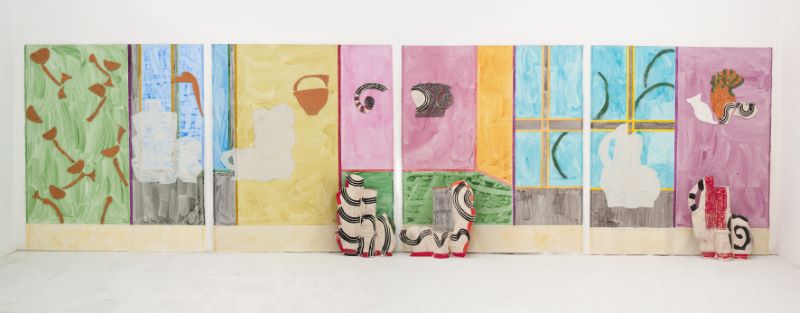L to R: Charles Woodman, Venice, Italy, 1966 / Charles Woodman and Francesca Woodman, Venice, Italy, 1966 / Betty Woodman and Charles Woodman, Venice, Italy, 1966. Woodman Family Foundation Archives.
Charles Woodman, Venice, Italy, 1966. Woodman Family Foundation Archives.
The Woodmans in Venice, Italy, 1966
As this year’s Venice Biennale, “The Milk of Dreams,” nears its end, we’re reminded that over many decades Betty and George Woodman traveled to Venice to take in the Biennale. Their trip in 1966—pictured here—when the family spent the year in Italy, was likely Charlie and Francesca’s first of many visits there, to explore both the exhibition and this captivating city.
L to R: George Woodman. “Beauty is Truth,” 1976. 52 x 52 in. Acrylic on canvas. Image courtesy RISD Museum | Francesca Woodman. “Charlie the Model #10,” 1976, 5 5/16 x 5 3/8 in. Lifetime gelatin silver print | Betty Woodman. “Pillow Pitcher: Rain Forest,” c. 1980s. 20 x 24 x 16 in. Glazed earthenware © Woodman Family Foundation / Artists Rights Society (ARS), New York
George Woodman. “Beauty is Truth,” 1976. 52 x 52 in. Acrylic on canvas © Woodman Family Foundation / Artists Rights Society (ARS), New York. Image courtesy RISD Museum.
RISD Museum Acquisitions
We’re thrilled that RISD Museum has acquired a group of important works by Betty, Francesca, and George Woodman from the Foundation’s holdings through a combination of museum funds and Foundation gifts. RISD occupies a singular place of importance for the Woodman family, from Francesca’s formative years there as a young artist and student to Betty’s 2005 solo exhibition at the museum and RISD Honorary Degree in 2009.
L to R: Betty Woodman, Italy, c. 1965-66 / Betty Woodman, Charles Woodman, and Francesca Woodman, Italy, c. 1960s / Charles Woodman and friend, Italy, c. 1966 / Betty Woodman and friends, Italy, c. 1966 / Betty Woodman, Francesca Woodman, and friend, Antella, Italy, c. 1968 / Betty Woodman and friends, Antella, Italy, c. 1980 / Betty Woodman, Antella, Italy, c. 1995 / George Woodman, Antella, Italy, c. 1995 / Betty Woodman, George Woodman, and friends, Antella, Italy, c. 1995. Woodman Family Foundation Archives.
Betty Woodman, Italy, c. 1965-66. Woodman Family Foundation Archives.
Dining al fresco with the Woodman family, c. 1960s-1995
The Woodman family spent many summer days and evenings dining al fresco in Italy with family and friends throughout the years. Most of these snapshots were taken by George, who often had his camera in hand and documented their family life.
The Woodman family and friends throughout the years in Antella, Italy, c. 1960s-2010s. Woodman Family Foundation Archives.
The Woodman family and friends, Antella, Italy, c. 1960s. Woodman Family Foundation Archives.
The breakfast nook, Antella, Italy, c. 1960s-2010s
For over fifty years, the Woodman family has enjoyed many meals and conversations in the breakfast nook at their farmhouse in Antella, Italy. Built in a circular space that had originally housed a brick oven, the nook overlooks the hills of Tuscany and spectacular sunsets.
L to R: 1-6: Betty Woodman. “Impruneta Flower Pots,” c. 1998-2004. Variable dimensions. Terracotta. Views in Antella, Italy | Betty Woodman with Tullio Orlandi, Italy, c. 1998-2004. Woodman Family Foundation Archives.
Betty Woodman. “Impruneta Flower Pots,” c. 1998-2004. Variable dimensions. Terracotta. Views in Antella, Italy. Woodman Family Foundation Archives.
Betty Woodman, "Impruneta Flowers Pots," c. 1998-2004, Antella, Italy
Over summers spent in Antella, Italy, Betty Woodman often developed projects which could only be realized there. From 1998-2004, she collaborated with a pottery in Impruneta—a nearby town renowned for its terra cotta clay—enlivening their standard-issue garden planters with her vase-shaped façades and signature brushstrokes.
Betty Woodman. “Portuguese Baroque,” 2013, 18 1/4 x 25 x 8 1/2 in. Glazed earthenware, epoxy resin, lacquer, paint © Woodman Family Foundation / Artists Rights Society (ARS), New York
ON VIEW: Betty Woodman in "Women's Work," Lyndhurst Mansion, Tarrytown, New York, 2022
Betty Woodman in “Women’s Work,” Lyndhurst Mansion, Tarrytown, New York. On view through September 26, 2022.
L to R: 1-2: Installation views of Betty Woodman's “Horizontal Garden” (2005), The Great Hall, The Metropolitan Museum of Art, 2006. 29 x 32 x 18 in. Glazed earthenware | Installation view of “The Art of Betty Woodman,” The Metropolitan Museum of Art, New York, NY, April 25—July 30, 2006. Photo: Eli Ping
Installation view of Betty Woodman's “Horizontal Garden” (2005), The Great Hall, The Metropolitan Museum of Art, 2006. 29 x 32 x 18 in. Glazed earthenware. Photo: Eli Ping.
Betty Woodman, Met Vases, 2006
Spring flowers always remind us of Betty Woodman, and particularly her vases in the Great Hall of the Metropolitan Museum of Art, which greeted visitors to the museum with their bold colors, overlapping patterns and allusions to vases and gardens, holding an ever-changing display of seasonal blooms. They were installed on the occasion of her 2006 retrospective there—the first time the museum dedicated such an exhibition to a living woman artist.
L to R: 1-4: All from Betty Woodman’s first trip to Fiesole, near Florence, Italy, 1951-52 / Soggiorno degli Stranieri in Italia ("Foreigner's Stay in Italy”) for Betty Woodman, 1951. Woodman Family Foundation Archives.
Betty Woodman’s first trip to Fiesole, near Florence, Italy, 1951-52. Woodman Family Foundation Archives.
Betty Woodman's trip to Fiesole, Italy, 1951-52
Betty Woodman first traveled to Italy in 1951, on the suggestion of her friends Grace and John Tagliabue who invited her to join them there. She spent the year in Fiesole, renting a room on a hillside overlooking Florence and its Duomo and working in a pottery studio owned by painter Giorgio Ferrero and sculptor Lionello Fallacara.
L to R: Betty Woodman working in her studio, Boulder, Colorado, c. 1960s / Betty Woodman’s functional ceramics notebook, c. 1966 / Betty Woodman with pots from kiln, Boulder, Colorado, c. 1960s. Woodman Family Foundation Archives.
Betty Woodman working in her studio, Boulder, Colorado, c. 1960s. Woodman Family Foundation Archives.
Betty Woodman's functional ceramics, 1960s
In the 1960s, Betty Woodman worked primarily in stoneware at her studio in Boulder, Colorado. At that time, she focused on producing functional ceramics, keeping careful notes about each piece.
L to R: Betty Woodman with Joyce Kozloff, 1981. Photo: Sylvia Plachy / 2-4: Betty Woodman, collaboration with Joyce Kozloff. “Cups," (3 of 12), 1980. 5 in. diameter / "Chrysanthemum Vase," 1980. 14 in / “Purple Toucan Pitcher,” 1980. 17 in. All glazed earthenware / 5-7: Betty Woodman, collaboration with Cynthia Carlson. Installation views, "An Interior Exchanged,” ArtisanSpace, Fashion Institute of Technology, New York, 1982. Dimensions variable. All paint and glazed ceramic.
Betty Woodman with Joyce Kozloff, 1981. Photo: Sylvia Plachy. Woodman Family Foundation Archives.
Betty Woodman, collaborations with Joyce Kozloff and Cynthia Carlson
In the early 1980s, as Betty Woodman moved into a New York City loft with her husband, George Woodman, and began to shift her functional practice towards ceramic sculpture, she became friends with many artists deeply involved with the Pattern and Decoration movement. She collaborated with two of them: Joyce Kozloff and Cynthia Carlson. With Kozloff, Woodman made ceramic forms—whether cups and saucers, pitchers or trays—which Kozloff then decorated with rich patterns inspired by Islamic tiles and motifs. The resulting works, which dissolve the line between craft and art, were shown in exhibitions at Tibor de Nagy Gallery and the Queens Museum in 1981.
Betty Woodman. Installation view and details, "Alessandro’s Rooms," 2011. 102.5 x 354.5 x 15.75 in. Glazed earthenware, epoxy resin, lacquer, acrylic paint, canvas © Woodman Family Foundation / Artists Rights Society (ARS), New York
Betty Woodman. "Alessandro’s Rooms," 2011. 102.5 x 354.5 x 15.75 in. Glazed earthenware, epoxy resin, lacquer, acrylic paint, canvas © Woodman Family Foundation / Artists Rights Society (ARS), New York
ON VIEW: Betty Woodman in "The Flames: The Age of Ceramics" at Musee d'Art Moderne de Paris, Paris, France, 2021
"The Flames" takes a transhistorical approach to ceramics to assert the critical relationship of clay to both art and humankind. The exhibition combines ancient objects dating back to the Neolithic with those made by contemporary artists—including Betty Woodman—and everything in between.
L to R: Entrance to the Woodman family’s farmhouse adorned with a Pillow Pitcher by Betty atop a wall of George’s “sgraffito,” 2017 / View of the olive groves from Betty’s studio, 2004 / Betty cutting well-tended roses growing against the wall next to her studio, 2008 / Betty making flower arrangements with roses, dahlias and gerbera daisies from her garden, 2006 / Betty putting fresh flowers in a group of her “Vase and Stand” works, 1984 / Betty, a young family friend, and Francesca, c. late 1960s / Table set for dinner, 2016, photo by Brigid McCaffrey / Generous bowls and baskets full of figs, plums, peaches, grapes, and tomatoes, 2016 / Betty, Charlie and Francesca cooking together, c. early 1970s / George at his studio door, 2006 / A view out from the same door, 2008 / Francesca and Betty holding their bunnies, c. 1968 / Charlie on his motorino, c. late 1960s / Betty and friend with Betty’s triptych “June in Italy” (2001), c. 2001 / George with his sculpture, c. early 1970s / he Woodman family’s patio with potted geraniums and the olive grove in view, c. 1990s / Morning glories climbing George’s “sgrafitto” wall, c. 1990s. Woodman Family Foundation Archives.
L to R: Entrance to the Woodman family’s farmhouse adorned with a Pillow Pitcher by Betty atop a wall of George’s “sgraffito,” 2017. Woodman Family Foundation Archives.
AUGUST IN ANTELLA
Beginning in the summer of 1968, the Woodman Family spent every summer at their stone farmhouse in Antella, Italy, just outside of Florence. As children, Charlie and Francesca joined their parents and later visited on their own, soaking in Italian culture and influences. Betty and George made some of their most important artistic breakthroughs there—a place George once described as "an artist residency for two.” All summer long, their garden produced abundant food and flowers—the tomatoes were particularly good in August, happily shared with frequent visitors.























